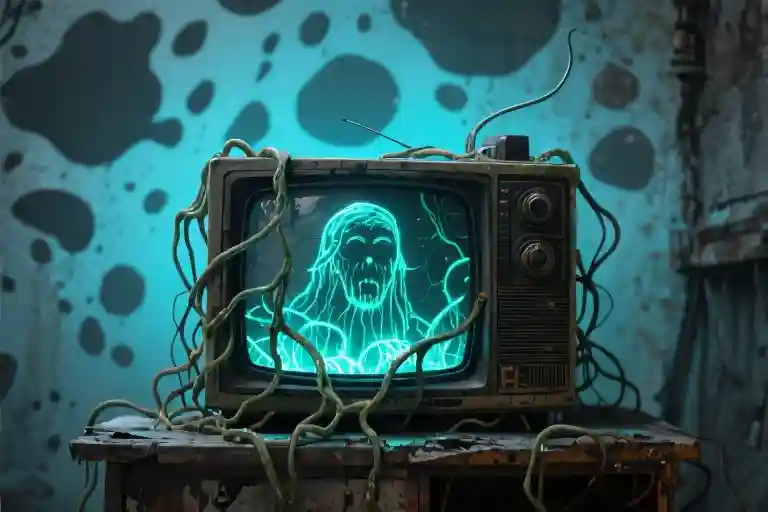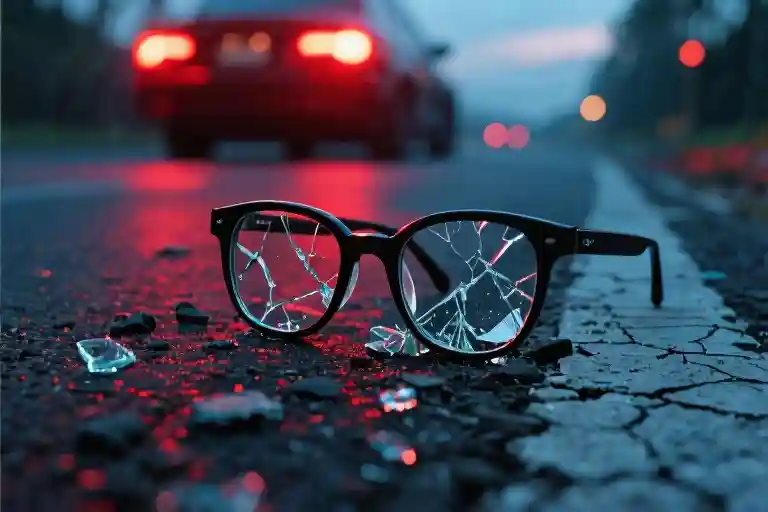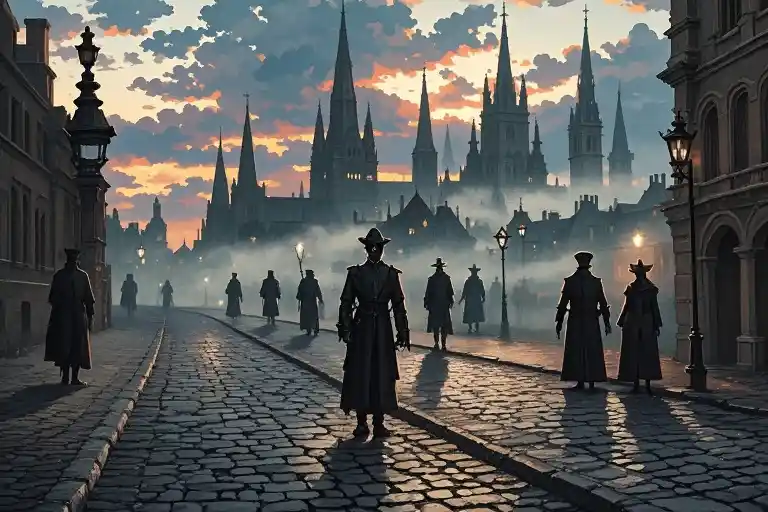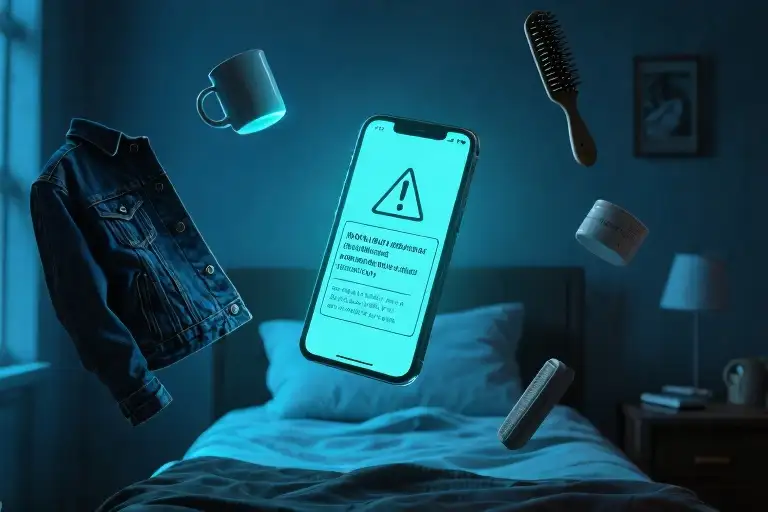There’s a particular kind of unease that lingers after experiencing Nick Antosca’s work—like an ice pick slowly turning the lock in your spinal column. His stories don’t just scare you; they rewrite your nervous system’s responses to darkness, to quiet rooms, to the mundane objects that might suddenly reveal their hidden malice. The most unsettling part? You’ll find yourself craving that discomfort again, like pressing a bruise to feel its tender ache.
For nearly a decade, I’ve had the privilege of watching this alchemy of terror unfold from the front row. When we first met, Nick was the quiet architect behind some of Hannibal’s most psychologically brutal episodes—including that devastating series finale that left fans gasping. What struck me then, and what continues to define his work, is how his horror operates on multiple frequencies simultaneously. It’s not just about what makes you jump; it’s about what makes you question whether that shadow just moved on its own, whether your childhood memories might be hiding something unspeakable, whether the person you love most might be something else entirely.
His creations—from the Lynchian nightmare of Brand New Cherry Flavor to the folk horror tapestry of Channel Zero—share this singular quality: they implant themselves in your subconscious and begin growing in directions you can’t predict. The fear feels earned because it’s rooted in emotional truth before the supernatural elements even appear. When the monsters do arrive (and they always do), they’re merely giving form to the existential dread that’s been building all along.
What separates Nick from other horror creators working today is his background as both a literary and visual storyteller. The short story ‘The Quiet Boy’ (which became the Guillermo del Toro-produced film Antlers) demonstrates this dual mastery—every sentence feels like a camera panning across a decaying landscape, revealing just enough to make your imagination do the heavy lifting. This cross-medium fluency allows his television work to achieve a rare depth; each Channel Zero season unfolds with the precision of a novella, where every image carries metaphorical weight beyond its surface terror.
Perhaps the greatest testament to his skill is how his work sparks conversation beyond typical horror fandom. Reddit threads dissect the feminist themes in Brand New Cherry Flavor’s body horror. Film students analyze the color theory in Channel Zero’s Candle Cove. Literary critics trace the lineage of his short stories back to Shirley Jackson’s domestic unease. This cultural ripple effect suggests something profound about modern horror—that the genre’s most vital voices aren’t just entertaining us, but mapping our collective anxieties with unsettling accuracy.
Over the next decade, as horror continues its creative renaissance, I suspect we’ll see Nick Antosca’s influence everywhere—in the shows that prioritize slow-burn dread over cheap jumpscares, in the films that trust audiences to sit with discomfort, in the stories that understand true terror begins long before the monster appears. The ice pick has already turned; the door is creaking open. All that remains is to step through.
From Screenwriter to Architect of Horror Universes
Nick Antosca’s journey through the landscape of modern horror began with surgical precision—fitting for a writer who cut his teeth on the third season of Hannibal. That final season was a masterclass in psychological tension, where every frame felt like a scalpel sliding between ribs. His episodes didn’t just conclude the story; they left nerve endings exposed to the air.
But it was Channel Zero where Antosca truly began building his own haunted houses. The anthology series did something radical at the time—it treated internet creepypasta not as campfire tales, but as contemporary folklore worthy of prestige television. Each season became a case study in adapting digital-age myths: the Candle Cove puppets with their jagged smiles, the No-End House’s ever-shifting corridors. These weren’t just scary stories—they were excavations of collective online trauma.
What’s fascinating is how Antosca operates on parallel tracks. While developing Channel Zero, he was also navigating Hollywood’s labyrinth with films like The Forest—a studio project that, despite its constraints, still bore his signature unease. Then came Antlers, adapted from his own short story The Quiet Boy. Here, the literary and cinematic strands converged: that eight-page story’s restrained terror blossomed into a full cinematic ecosystem, with Guillermo del Toro’s fingerprints on the creature design.
This dual-track approach reveals Antosca’s particular genius. Where many horror creators specialize—TV auteurs, film directors, literary voices—he moves fluidly between formats. The short stories inform the screenplays, the TV shows borrow from cinematic pacing, and it all coalesces into a singular vision. Not since Stephen King has a horror storyteller so successfully colonized multiple mediums, and even King never had to contend with adapting 4chan-born myths for basic cable.
What ties these disparate projects together? A preoccupation with infection—not of the body, but of the mind. Whether it’s Hannibal‘s gourmet cannibalism or Channel Zero‘s memory-distorting houses, Antosca’s horrors metastasize psychologically. They’re less about what jumps from the shadows than what stays with you after the lights come on.
Now, as he pivots to true-crime hybrids like The Act and Candy, that same sensibility persists—because the scariest stories, as Antosca keeps proving, aren’t the ones with monsters, but the ones where the monster might just be human.
Defining a Horror Visionary Through Three Signature Works
Nick Antosca’s creative output operates like a surgical instrument – precise in its incisions, deliberate in leaving fragments of unease that reassemble themselves in your subconscious. What separates him from contemporary horror practitioners isn’t just technical proficiency, but an almost alchemical ability to transmute familiar fears into startling new configurations. Three projects in particular – Channel Zero, Antlers, and Brand New Cherry Flavor – serve as crystalline formations of his evolving horror philosophy.
Channel Zero: Digital Folklore’s Bloody Reckoning
When Syfy greenlit an anthology adapting creepypasta stories, few anticipated how thoroughly Antosca would dismantle internet horror tropes. Each season became a masterclass in psychological world-building:
- Candle Cove (Season 1) transformed pixelated online rumors into tactile nightmare fuel, using practical puppetry to make childhood nostalgia curdle
- No-End House (Season 2) architecturally manifested grief through its shifting labyrinth, where doorways led to personalized emotional torture chambers
- Butcher’s Block (Season 3) spliced class anxiety with Lovecraftian horror, its cannibalistic aristocracy lurking behind gentrified facades
The genius lay not in direct adaptations, but in treating online myths as cultural fossils – artifacts begging for anthropological excavation. Where most horror about technology feels dated by production time, Channel Zero tapped into primal fears beneath the digital veneer: isolation, unreliable memory, the terror of being replaced by warped versions of oneself.
Antlers: When Short Stories Grow Teeth
Adapting his own 2019 short story The Quiet Boy presented unique challenges. The original eight-page piece worked through implication, its wendigo mythology lurking in negative space. Expanding this into a feature required:
- Environmental Horror – The decaying Oregon mining town became a character, its economic rot mirroring the creature’s consumption cycle
- Monster Ethics – Del Toro’s influence surfaces in the creature’s tragic dimensions, a far cry from typical Hollywood beast design
- Paternal Horror – Unlike most creature features, the true terror stemmed from parental failure rather than the monster itself
Cinematographer Florian Hoffmeister’s decision to shoot in perpetual twilight created an unsettling liminal space – not quite night nor day, much like the protagonist’s trapped existence between childhood and trauma.
Brand New Cherry Flavor: Neon-Soaked Body Revolt
Perhaps Antosca’s most audacious work, this Netflix limited series blended:
- 90s Grunge Aesthetic – Not the sanitized nostalgia of Stranger Things, but the sticky, nicotine-stained reality of underground art scenes
- Feminist Revenge – Rosa Salazar’s Lisa Nova undergoes bodily violations that invert traditional horror victimhood into transformative rage
- Surrealist Rules – The show’s internal logic follows dream physics, where kittens vomit from phone receivers and tattoos gain sentience
Production designer Ramsey Avery created a Los Angeles that feels perpetually damp, its vibrant colors somehow making the bodily horrors more visceral. The series’ greatest trick was making viewers question whether they were watching a descent into madness or a supernatural awakening.
What unites these projects is Antosca’s refusal to let horror become comfortable. Just when you identify a pattern – be it anthology structures, creature features, or revenge narratives – he injects mutating elements that defy categorization. The true terror lies in this stylistic shape-shifting, leaving audiences without stable ground to stand upon.
Channel Zero: Folk Horror for the Digital Age
Nick Antosca’s Channel Zero did something remarkable in the horror anthology space—it treated internet creepypasta not as campfire fodder, but as legitimate folklore for our times. Where most adaptations would amplify jump scares or CGI monsters, Antosca’s approach was surgical: he extracted the psychological marrow from stories like Candle Cove and No-End House, leaving viewers with something far more lingering than simple frights.
The Creepypasta Alchemy
Adapting online horror tales presents a unique challenge—their power often lies in ambiguity and the reader’s own imagination. Channel Zero solved this by treating each season as a character study wrapped in myth. Take No-End House: what began as a brief forum post about an endless maze of rooms became a meditation on grief and memory. Antosca preserved the story’s eerie premise while adding emotional weight—the house didn’t just terrify; it mirrored each character’s deepest regrets. This became his signature move: using horror as an X-ray for human fragility.
Visual Language of Unease
The show’s brilliance shines in its visual storytelling. No-End House‘s endless corridors weren’t just a set design trick—they manifested the cyclical nature of trauma. Repeating wallpapers, looping hallways, and that haunting yellow door created a subliminal discomfort. It’s textbook psychological horror: the environment itself becomes the monster. Antosca collaborated closely with directors to ensure every frame felt almost normal, with just enough wrongness to trigger unease—a family dinner scene where the silverware is slightly misaligned, or a childhood bedroom where the doll collection grows overnight.
Why It Resonates
What set Channel Zero apart from other horror anthologies was its patience. While American Horror Story relied on shock value, Antosca’s series understood that true dread accumulates. The infamous Candle Cove puppets worked precisely because they appeared intermittently—each glimpse fraying the viewer’s nerves further. This restraint made the payoffs devastating: when No-End House finally revealed its ‘exit’, the emotional release was as crushing as the preceding terror. It’s this balance—between slow-burn tension and cathartic horror—that cemented Channel Zero‘s cult status.
Antosca proved that internet-born horror could carry profound weight. By treating creepypasta as modern mythology—complete with psychological depth and visual poetry—Channel Zero became more than an adaptation. It was a blueprint for how to translate digital-age fears into timeless stories.
The Alchemy of Adaptation: From Page to Screen
Nick Antosca’s Antlers represents one of those rare cases where a short story’s essence isn’t just preserved in translation to film—it mutates into something equally potent but fundamentally different. His original 8-page story The Quiet Boy (published in Guillermo del Toro’s The Hollow Ones) contained all the genetic material that would later grow into the 2021 feature film: the rural Oregon setting, the teacher discovering her student’s dark secret, that grotesque wendigo mythology. But what fascinates me about this adaptation isn’t the faithfulness to source material—it’s the strategic expansions that reveal Antosca’s understanding of each medium’s unique horrors.
Short stories thrive on implication. When young Lucas in The Quiet Boy whispers “He’s hungry” about his father, the terror blooms in the white space between sentences. Film demands visual grammar—hence the movie’s opening sequence where miners break into a cavernous lair, their headlamps illuminating something that makes one whisper “Oh God” before the screen cuts to black. That’s adaptation as alchemy: transforming literary dread into cinematic punctuation.
The environmental metaphors buried in the original story get room to breathe on screen. Where the short story hints at meth labs poisoning the land, the film makes the wendigo an explicit manifestation of nature’s revenge—rotting deer carcasses piling up like accusations, the monster itself a grotesque amalgam of antlers and starving human limbs. Production designer Jeremy Woodward told Bloody Disgusting they modeled the creature’s lair on “coal mines that look like ribcages,” a perfect visual metaphor for consumption consuming itself.
What surprises most about Antlers isn’t the creature effects (though the wendigo remains one of the decade’s most unsettling designs), but how Antosca and co-writer Henry Chaisson expanded the human drama. Keri Russell’s teacher Julia becomes a recovering addict, her brother (Jesse Plemons) the local sheriff drowning in opioid prescriptions—layers that transform a monster flick into a portrait of American decay. That’s the real magic trick here: making a film where the supernatural horror feels secondary to the human tragedies unfolding in its shadow.
Perhaps the boldest departure from the source material comes in the third act. Without spoiling, let’s just say the short story’s ambiguous ending gets replaced by something more visceral but equally thematically rich—a choice that divided critics but perfectly illustrates Antosca’s philosophy. As he told The New York Times: “Horror works best when it’s about something real, even if that something wears antlers and eats children.”
The Psychedelic Vengeance of Brand New Cherry Flavor
There’s something deeply unsettling about the way Nick Antosca’s Brand New Cherry Flavor lingers in your subconscious. It’s not just the body horror – though there’s plenty of that – but how the series weaponizes Los Angeles’ sun-bleached nostalgia against its protagonist. The 90s setting isn’t mere backdrop; it’s an active participant in the horror, with that particular decade’s grunge aesthetic becoming increasingly corrupted as the story progresses.
What begins as a straightforward revenge tale about filmmaker Lisa Nova (Rosa Salazar) quickly spirals into something far more primal. The supernatural elements creep in slowly – a tattoo that moves when unobserved, mysterious bruises that form overnight – until the show’s reality becomes as unstable as its protagonist’s mental state. Antosca and co-creator Lenore Zion construct their horror not through jump scares, but through the gradual erosion of bodily autonomy. When Lisa vomits up a hairball containing a kitten (yes, really), the moment plays less like shock value and more like a grotesque metaphor for creative labor.
This brings us to the show’s most fascinating tension: its feminist horror core. Lisa’s journey mirrors the real-world exploitation young women face in Hollywood, amplified through supernatural means. The mysterious Boro (Catherine Keener) initially appears as a mentor figure before revealing herself as yet another predator in a system full of them. Her witchcraft doesn’t empower Lisa so much as it weaponizes her trauma – a sharp commentary on how society often expects victims to transform their suffering into art.
Visually, the series employs what I’ve come to think of as “toxic neon” – vibrant pinks and purples that should feel playful, but instead create a sickly, artificial glow. Cinematographer Carl Herse lenses Los Angeles not as the City of Angels, but as a liminal space where reality has begun to fray. The color palette grows increasingly saturated as Lisa loses control, until even daylight scenes feel hallucinatory.
What makes Brand New Cherry Flavor quintessential Antosca is how it resists easy categorization. Is it body horror? A Hollywood satire? A psychedelic nightmare? The answer seems to be “yes” – and that refusal to conform to genre expectations makes it one of his most distinctive works. While not as widely discussed as Channel Zero or Antlers, it represents perhaps his purest creative vision: unsettling, visually daring, and unapologetically weird.
The Outsider’s Voice in Horror
Nick Antosca’s work hums at a frequency most horror creators can’t access. Where Stephen King builds terror brick by brick with exhaustive character backstories and small-town mythologies, Antosca operates through surgical incisions – a single unnerving image (a child’s drawing in “Channel Zero”, the unnatural movements in “Antlers”) that metastasizes in your subconscious. Their approaches represent two poles of the genre: King’s comforting campfire tales versus Antosca’s clinical case studies.
This distinction crystallizes in their treatment of monsters. King’s creatures often roar into full view (Pennywise’s circus grotesquerie, Cujo’s foaming jaws), while Antosca’s linger at the edge of perception. Consider how “The Quiet Boy” (the short story behind “Antlers”) withholds its wendigo’s true form until the final act – and even then, through fragmented glimpses. It’s horror as Rorschach test, where audiences paint their worst fears onto Antosca’s carefully constructed voids.
Within the A24-led revolution of elevated horror, Antosca carves a peculiar niche. Where Ari Aster’s “Hereditary” weaponizes family drama into Greek tragedy, or Robert Eggers’ “The Witch” roots terror in historical authenticity, Antosca’s stories feel like dispatches from a glitching reality. “Brand New Cherry Flavor” epitomizes this – its neon-soaked LA isn’t just a setting but a sentient nightmare where concrete breathes and phone static whispers secrets. The show’s infamous body horror sequences (a particular vomiting scene lives rent-free in fans’ minds) don’t shock for gore’s sake, but as manifestations of psychological disintegration.
Critical reception highlights this divergence. While Aster’s work garners academic analysis for its symbolism, Antosca’s shows spark Reddit threads debating whether certain scenes “really happened” or were hallucinations. This ambiguity divides audiences: some praise his restraint (the unseen horrors in “Channel Zero: No-End House”), while others crave clearer resolution. Even within the horror community, you’ll find heated arguments about whether his open-ended approach constitutes depth or cop-out.
Yet perhaps Antosca’s true innovation lies in pacing. Modern horror often builds to explosive third acts (“Hereditary”‘s attic climax, “Midsommar”‘s fiery finale), but his stories simmer without boiling over. The terror in “Channel Zero: Candle Cove” accumulates through subtle wrongness – a children’s show that shouldn’t exist, puppets moving without strings. It’s the horror equivalent of a slowly tightening vice, where audiences realize too late they’ve been trapped.
What emerges is a creator redefining dread for the digital age. Where King mastered the slow creep of fear across generations, and A24 auteurs explore existential terror, Antosca captures the paranoia of living in a world where reality itself feels unstable. His work doesn’t just scare you – it makes you question whether you ever stopped being afraid.
The Polarizing Effect of Antosca’s Horror
Nick Antosca’s work doesn’t just divide audiences—it fractures them. There’s no comfortable middle ground when experiencing his brand of psychological horror. You either become one of those obsessive fans who creates Tumblr art of the Candle Cove puppets at 3am, or you’re the critic writing think pieces about ‘style over substance’ for The Hollywood Reporter. Both reactions, interestingly enough, prove he’s doing something right.
On Reddit’s horror forums, you’ll find threads dissecting every frame of Brand New Cherry Flavor like it’s the Zapruder film. Users with names like ‘NoEndHouseStan’ post 5,000-word analyses about the feminist subtext in the body horror sequences. Someone inevitably brings up how they had to sleep with the lights on for a week after watching Antlers. These aren’t casual viewers—they’re converts in a cult where Antosca serves as both high priest and tormentor.
Meanwhile, mainstream outlets often seem perplexed by his work. The Hollywood Reporter’s review of Channel Zero called it ‘deliberately obtuse,’ while Variety praised its visuals but questioned whether the ‘narrative payoff justified the discomfort.’ There’s an academic stiffness to these critiques that misses the point entirely. Antosca isn’t trying to balance scales between payoff and discomfort—he wants the discomfort to be the payoff.
What fascinates me most is how this divide mirrors reactions to early David Lynch projects. Both creators understand that true horror lingers in ambiguity, in those half-glimpsed moments that resist explanation. When mainstream critics complain about Antosca’s plots being ‘underdeveloped,’ they’re revealing their own preference for neatly packaged fear. His fans, conversely, embrace the lingering unease as feature rather than flaw.
The polarization extends to his literary work too. The original short story The Quiet Boy provoked such strong reactions that Guillermo del Toro personally called Antosca about film rights. Yet when Antlers finally premiered, some viewers complained it was ‘too literary’ for a monster movie. That tension—between arthouse sensibility and genre expectations—defines Antosca’s career. He’s not interested in making easily classifiable horror, and that refusal to conform guarantees both his cult following and his critical resistance.
Perhaps the healthiest perspective comes from the Syfy executives who greenlit Channel Zero. They reportedly told Antosca, ‘We don’t fully understand what you’re doing, but we know it’s working.’ That sums up his relationship with audiences perfectly. You don’t need to intellectually comprehend why that particular camera angle in No-End House made your palms sweat. You just need to trust the man who put it there knows exactly what he’s doing to you.
The Unfinished Nightmare: Where Antosca’s Horror Goes Next
Nick Antosca’s stories never really leave you. They’re the kind that linger in your peripheral vision, like a shadow that moves just as you turn your head. Now he’s turning that unsettling gaze toward true crime with his latest project, Candy – a departure that somehow feels inevitable. If you’ve followed his career from Channel Zero‘s surreal nightmares to Brand New Cherry Flavor‘s psychedelic revenge tale, you’ll recognize the same fingerprints on this new crime story: the slow-burn dread, the way ordinary lives curdle into violence, the sense that horror was hiding in plain sight all along.
What makes Candy particularly intriguing is how it continues Antosca’s fascination with domestic horror. Where The Act explored the warped intimacy between Dee Dee and Gypsy Rose Blanchard, Candy digs into another infamous suburban crime – the 1980 Texas axe murder. It’s classic Antosca territory: taking something that should feel safe (a neighborhood, a marriage) and showing the rot beneath the surface. Jessica Biel’s performance as the killer housewife already has critics drawing comparisons to The Act‘s Patricia Arquette, suggesting we’re in for another masterclass in psychological horror disguised as true crime.
For those just discovering Antosca’s work, here’s how to navigate his growing catalog without losing your sanity:
- Start with Channel Zero: No-End House (Season 2) – The perfect introduction to his brand of existential dread, blending creepypasta lore with devastating character studies.
- Move to The Act – Witness how he transforms tabloid true crime into Shakespearean tragedy.
- Dive into Brand New Cherry Flavor – His most unhinged creation, where body horror meets Hollywood satire.
- Read The Quiet Boy (the short story) then watch Antlers – Study how his prose adapts to film.
- End with Candy – The logical next step in his exploration of American darkness.
What’s remarkable isn’t just the variety – from supernatural anthologies to fact-based crime dramas – but how distinctly his everything feels. Whether it’s a monster lurking in the Oregon woods or a Texas housewife swinging an axe, Antosca finds the same terrifying truth: we’re all just one bad decision away from becoming the thing we fear. That thread connects Hannibal‘s gourmet cannibal to Candy‘s killer next door, proving horror doesn’t need ghosts when we have human nature.
There’s comfort in knowing the nightmare isn’t over. With Candy‘s success already spawning talk of a second season (reportedly exploring another infamous crime), and rumors of new Channel Zero installments, Antosca’s particular brand of discomfort seems here to stay. Consider this your survival guide – because in his world, the scariest stories are the ones we can’t stop watching.




